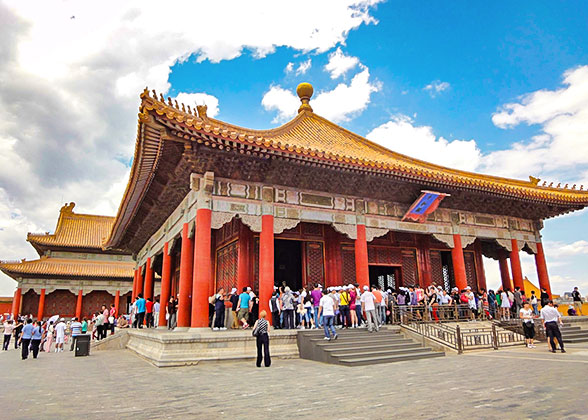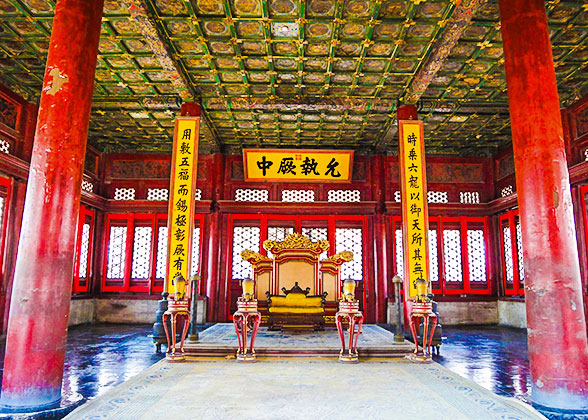Hall of Central Harmony (Zhonghedian)
The Hall of Central Harmony is located between the Hall of Supreme Harmony (Taihedian) and the Hall of Preserved Harmony (Baohedian). These three, known as the Three Great Halls of the Outer Court, are on the central axis of the Forbidden City. Of the three, it is the smallest. Covering a total area of 580 square meters, it is a square structure built like a pavilion, each side of which is five bays long, measuring 24.15m. It has a single-eaved roof with a gilded pinnacle gleaming brightly in the sunshine. A bird's eye view shows the architectural arrangement of the three halls avoids monotony, presenting the charm of Chinese architectural style, indicating the high level of expertise of the ancient architects.
Built in 1420, the eighteenth year of the reign of Emperor Yongle (1403-1424), the Hall of Central Harmony was named "Huagaidian" at the beginning of the Ming Dynasty (1368-1644). In the reign of Emperor Jiajing (1522-1566), it was fired and renamed "Zhongjidian" after reconstruction. The ink marks of the three Chinese characters (Zhong Ji Dian) can still be seen. The Qing imperial household came to live in the Forbidden City in the first year of the reign of Emperor Shunzhi (1644-1661), and called it "Zhonghedian" instead of "Zhongjidian" the next year. The two Chinese characters, "zhong" and "he", imply that each party can be satisfied only if they are treated without any bias, promoting "the golden mean" of Confucius. Having undergone three fires, the present takes on the look of what it was after reconstruction in 1627, the seventh year of Emperor Tianqi (1621-1627) of the Ming Dynasty (1368-1644).
The Hall of Central Harmony served as a place for rest for the emperor when he was on his way to hold ceremonies in the Hall of Supreme Harmony. When everything was ready, he would go to the Hall of Supreme Harmony to receive homage. It was here that he consulted with his ministers and officials. Each year prior to their departure for important sacrificial rites at the Temple of Heaven, the Temple of the Earth or elsewhere, he would come here to prepare elegiac addresses. Before going to the Altar of the God of Agriculture (Xiannongtan) to plow land and sew seeds himself every spring, the emperor would check the seeds and farming tools used in the ceremony here. The imperial family tree of the Qing Dynasty was complied once every decade. When the compilation was finished, it would be sent to the emperor to be examined, which was also done in it.
Inside the Hall of Central Harmony, visitors can see a pair of golden unicorns standing on each side of the throne in the center. Called "luduan" in Chinese, the unicorns were imagined mythological animals and believed to be multilingual and capable of traveling 5592.34 miles (9,000 kilometers) in a single day. Therefore, gargoyles of these mythical beasts, which served as sandalwood burners, were put around the throne as a symbol of the great wisdom and intelligence of the emperor. On the flat ground stand bronze incense burners used to make fire to keep warm. Beside the throne are two sedan chairs used to shuttle the emperor around the Forbidden City. There were rigid regulations concerning the occasion and the kind of sedan chair the emperor should take.
 Next:
Next:
Go north to visit the Hall of Preserved Harmony (Baohedian).
 Further Reading:
Further Reading:
How to visit the Forbidden City
Built in 1420, the eighteenth year of the reign of Emperor Yongle (1403-1424), the Hall of Central Harmony was named "Huagaidian" at the beginning of the Ming Dynasty (1368-1644). In the reign of Emperor Jiajing (1522-1566), it was fired and renamed "Zhongjidian" after reconstruction. The ink marks of the three Chinese characters (Zhong Ji Dian) can still be seen. The Qing imperial household came to live in the Forbidden City in the first year of the reign of Emperor Shunzhi (1644-1661), and called it "Zhonghedian" instead of "Zhongjidian" the next year. The two Chinese characters, "zhong" and "he", imply that each party can be satisfied only if they are treated without any bias, promoting "the golden mean" of Confucius. Having undergone three fires, the present takes on the look of what it was after reconstruction in 1627, the seventh year of Emperor Tianqi (1621-1627) of the Ming Dynasty (1368-1644).
The Hall of Central Harmony served as a place for rest for the emperor when he was on his way to hold ceremonies in the Hall of Supreme Harmony. When everything was ready, he would go to the Hall of Supreme Harmony to receive homage. It was here that he consulted with his ministers and officials. Each year prior to their departure for important sacrificial rites at the Temple of Heaven, the Temple of the Earth or elsewhere, he would come here to prepare elegiac addresses. Before going to the Altar of the God of Agriculture (Xiannongtan) to plow land and sew seeds himself every spring, the emperor would check the seeds and farming tools used in the ceremony here. The imperial family tree of the Qing Dynasty was complied once every decade. When the compilation was finished, it would be sent to the emperor to be examined, which was also done in it.
|
|
Inside the Hall of Central Harmony, visitors can see a pair of golden unicorns standing on each side of the throne in the center. Called "luduan" in Chinese, the unicorns were imagined mythological animals and believed to be multilingual and capable of traveling 5592.34 miles (9,000 kilometers) in a single day. Therefore, gargoyles of these mythical beasts, which served as sandalwood burners, were put around the throne as a symbol of the great wisdom and intelligence of the emperor. On the flat ground stand bronze incense burners used to make fire to keep warm. Beside the throne are two sedan chairs used to shuttle the emperor around the Forbidden City. There were rigid regulations concerning the occasion and the kind of sedan chair the emperor should take.
Go north to visit the Hall of Preserved Harmony (Baohedian).
How to visit the Forbidden City
- Last updated on Aug. 16, 2024 by Gabby Li -

